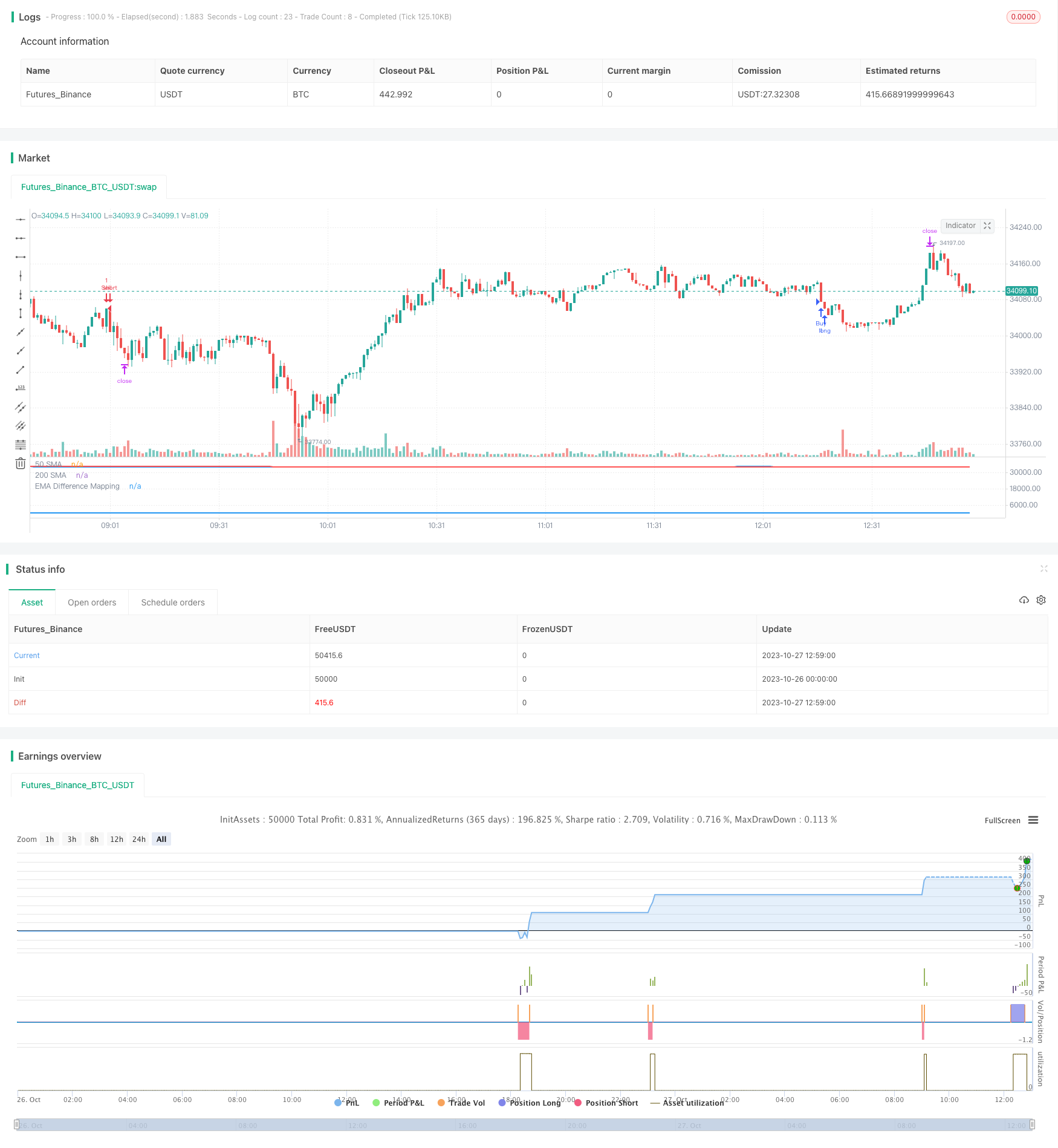
概述
本策略使用两条移动平均线的交叉作为交易信号,并结合波幅指标BB和自定义动能指标进行过滤,旨在提高MA交叉信号的可靠性,减少假信号。
原理
使用50周期EMA和200周期SMA形成金叉死叉信号。
当价格在上升趋势时,要求价格高于200日线且自定义动能指标值小于25才产生买入信号。
当价格在下降趋势时,要求价格低于200日线且自定义动能指标值大于75才产生卖出信号。
自定义动能指标根据BB中线与上下轨的距离映射到0-100范围。通过回溯统计距离最大最小值,进行归一化处理。
动能指标能体现价格相对波幅的位置信息,设置阈值进行过滤,可有效减少假交叉。
优势分析
利用EMA和SMA的优势,捕捉中长线趋势。
增加动能指标进行滤波,可靠性更高,减少假信号。
BB上下轨距离反映波动力度,结合回溯统计进行标准化处理,避免参数依赖。
可自定义EMA和SMA周期及动能指标阈值,适应不同市场环境。
策略思路清晰易懂,参数调优空间大,实操性强。
风险分析
EMA和SMA本身存在滞后性,可能错过短线机会。
双线交叉本质上是趋势跟踪策略,不适合震荡行情。
动能指标阈值需要反复回测确定合适参数,存在曲优化风险。
大周期均线策略,收益相对稳定但绝对收益可能有限。
可适当缩短均线周期,或增加其他指标辅助判断,提高策略的适应性。
优化方向
测试不同均线组合,寻找最佳参数。
增加其他指标判断,如MACD,KD等辅助判断。
优化动能指标的参数,如回溯周期,映射范围等。
添加止损机制来控制风险。
不同品种参数不一致,可考虑采用机器学习特征提取。
加入量能指标,避免不合理的交叉信号。
总结
本策略集大周期趋势跟踪和自定义动能指标双重过滤的优势于一身,可靠性高,实战价值强。通过参数优化和辅助技术指标补强,可望获得更出色的表现。该策略思路新颖,可为其他趋势跟踪策略提供借鉴,是量化交易策略库中一个有价值的补充。
/*backtest
start: 2023-10-26 00:00:00
end: 2023-10-27 13:00:00
period: 1m
basePeriod: 1m
exchanges: [{"eid":"Futures_Binance","currency":"BTC_USDT"}]
*/
//@version=4
strategy(title="EMA Difference Mapping with Trades", shorttitle="EMA Diff Map", overlay=false)
// Inputs
emaLength = input(20, "EMA Length")
stdDevLength = input(2, "Standard Deviation Length")
priceSource = close
takeProfitPoints = input(1000, title="Take Profit (in Points)")
stopLossPoints = input(2500, title="Stop Loss (in Points)")
// Calculate EMA
ema = ema(priceSource, emaLength)
// Calculate Standard Deviation
stdDev = stdev(priceSource, stdDevLength)
// Calculate differences
diff1 = (ema + stdDev) - ema
diff2 = ema - (ema - stdDev)
// Calculate min and max differences from last year
lookbackPeriod = 504 // Number of trading days in a year
minDiff1 = lowest(diff1, lookbackPeriod)
maxDiff1 = highest(diff1, lookbackPeriod)
minDiff2 = lowest(diff2, lookbackPeriod)
maxDiff2 = highest(diff2, lookbackPeriod)
// Map differences based on requirements
mappedDiff1 = 50 + 50 * ((diff1 - minDiff1) / (maxDiff1 - minDiff1))
mappedDiff2 = 50 - 50 * ((diff2 - minDiff2) / (maxDiff2 - minDiff2))
// Combine mapped differences into a single line
mappedLine = if close > ema
mappedDiff1
else
mappedDiff2
// Plot 'mappedLine' in the main chart area conditionally
plot(mappedLine, title="EMA Difference Mapping", color=(close > ema ? color.blue : na), style=plot.style_line, linewidth=2)
// Calculate the 50EMA and 200SMA
ema50 = ema(close, 50)
sma200 = sma(close, 200)
// Plot the 50EMA and 200SMA on the main chart
plot(ema50, color=color.blue, title="50 SMA", linewidth=2)
plot(sma200, color=color.red, title="200 SMA", linewidth=2)
// Initialize trade variables
var bool waitingForBuy = na
var bool waitingForSell = na
var bool buyConditionMet = false
var bool sellConditionMet = false
if not sellConditionMet and crossunder(ema50, sma200)
sellConditionMet := true
waitingForBuy := false
if sellConditionMet
waitingForSell := true
sellConditionMet := false
if waitingForSell and close < sma200 and mappedLine > 75
strategy.entry("Sell", strategy.short)
strategy.exit("Sell Exit", "Sell", profit=takeProfitPoints, loss=stopLossPoints)
waitingForSell := false
// Define the strategy conditions and execute trades
if not buyConditionMet and crossover(ema50, sma200)
buyConditionMet := true
waitingForSell := false
if buyConditionMet
waitingForBuy := true
buyConditionMet := false
if waitingForBuy and close > sma200 and mappedLine < 25
strategy.entry("Buy", strategy.long)
strategy.exit("Buy Exit", "Buy", profit=takeProfitPoints, loss=stopLossPoints)
waitingForBuy := false